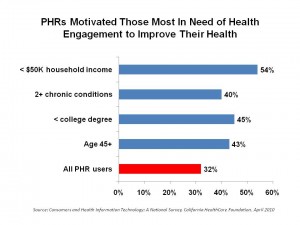The U.S. spent $2.3 trillion on health care in 2008. 75% of that went to chronic conditions.
How to move the needle on the long-term deficit challenge to the U.S. economy?
Think: personal health records (PHRs).
People with 2 or more chronic conditions find value in personal health records. So do people with less than a high school education, and those with household income under $50K.
The California HealthCare Foundation conducted the most detailed survey into consumers’ use of personal health records, and what people value about the tool. Among many measures, the one I’m focusing on here is, “The PHR led me to do something to improve my health.”
That’s true health engagement. And the lightbulb moment of this survey for me is illustrated by the above chart: that while 32% of all PHR users said the PHR led them to do something to improve their health, half again as many people with lower incomes said the PHR motivated them to behave more healthfully. And for people with 2 or more chronic conditions, 40% said they were led to do something to improve their health by using their PHR.

The CHCF survey results are very encouraging, especially for the under-served patient populations I mention here. But not every health citizen lives in a Kaiser-world where of the plan’s 8 million enrollees, 3 million use KP’s My Health Manager, the plan’s PHR.
PHRs can be sponsored by and channeled through a variety of trusted intermediaries: doctors and local health systems have the highest credibility with health citizens, according to CHCF’s poll. But interestingly, 25% of Americans say they’d be interested to receive a PHR through Google or Microsoft, and more through a trusted advocacy organization such as the American Cancer Society or the American Diabetes Association.
There is a great opportunity for a bit of disruption by consumer technology and even entertainment companies to bring their expertise into PHR development. Note that this month, a pilot program was announced by Meridian Health System of New Jersey and Best Buy, the electronic retailer, to market mobile health products to consumers. This gets to the retail, consumer-facing aspects of health in 2010 for many Americans and could be an important source for a certain segment of health citizens.
Another important point comes from CHCF’s recent study jointly done with the Pew Internet & American Life Project, Chronic Disease and the Internet, found that 52% of people with 2 or more chronic conditions have internet access — many fewer than the 81% overall population of Americans with access. Furthermore, only 37% of people with 2 or more chronic conditions have broadband at home, and 24% have wireless access compared to 50% of Americans, overall, with wireless.
In this regard, the FCC Broadband Report has a rich chapter on the importance of broadband for health care in America. A large percentage of people with chronic conditions don’t have access to broadband, which could make the PHR experience richer and more sustained over time. Therefore, health plan sponsors should consider subsidizing broadband to the home for patients who want to engage with PHRs and digital at-home medical devices as part of an overall prescription for whole, participatory health.
That’s how you bend the cost curve.





 Interviewed live on BNN Bloomberg (Canada) on the market for GLP-1 drugs for weight loss and their impact on both the health care system and consumer goods and services -- notably, food, nutrition, retail health, gyms, and other sectors.
Interviewed live on BNN Bloomberg (Canada) on the market for GLP-1 drugs for weight loss and their impact on both the health care system and consumer goods and services -- notably, food, nutrition, retail health, gyms, and other sectors. Thank you, Feedspot, for
Thank you, Feedspot, for  As you may know, I have been splitting work- and living-time between the U.S. and the E.U., most recently living in and working from Brussels. In the month of September 2024, I'll be splitting time between London and other parts of the U.K., and Italy where I'll be working with clients on consumer health, self-care and home care focused on food-as-medicine, digital health, business and scenario planning for the future...
As you may know, I have been splitting work- and living-time between the U.S. and the E.U., most recently living in and working from Brussels. In the month of September 2024, I'll be splitting time between London and other parts of the U.K., and Italy where I'll be working with clients on consumer health, self-care and home care focused on food-as-medicine, digital health, business and scenario planning for the future...